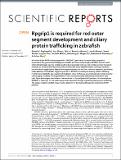Files in this item
Rpgrip1 is required for rod outer segment development and ciliary protein trafficking in zebrafish
Item metadata
| dc.contributor.author | Raghupathy, Rakesh K. | |
| dc.contributor.author | Zhang, Xun | |
| dc.contributor.author | Liu, Fei | |
| dc.contributor.author | Alhasani, Reem H. | |
| dc.contributor.author | Biswas, Lincoln | |
| dc.contributor.author | Akhtar, Saeed | |
| dc.contributor.author | Pan, Luyuan | |
| dc.contributor.author | Moens, Cecilia B. | |
| dc.contributor.author | Li, Wenchang | |
| dc.contributor.author | Liu, Mugen | |
| dc.contributor.author | Kennedy, Breandan N. | |
| dc.contributor.author | Shu, Xinhua | |
| dc.date.accessioned | 2018-01-04T13:30:13Z | |
| dc.date.available | 2018-01-04T13:30:13Z | |
| dc.date.issued | 2017-12-04 | |
| dc.identifier | 251875575 | |
| dc.identifier | 3be8178d-470f-4cd8-af64-6d208b497476 | |
| dc.identifier | 85037040611 | |
| dc.identifier | 000417025400062 | |
| dc.identifier.citation | Raghupathy , R K , Zhang , X , Liu , F , Alhasani , R H , Biswas , L , Akhtar , S , Pan , L , Moens , C B , Li , W , Liu , M , Kennedy , B N & Shu , X 2017 , ' Rpgrip1 is required for rod outer segment development and ciliary protein trafficking in zebrafish ' , Scientific Reports , vol. 7 , 16881 . https://doi.org/10.1038/s41598-017-12838-x | en |
| dc.identifier.issn | 2045-2322 | |
| dc.identifier.other | ORCID: /0000-0002-1179-6636/work/64361115 | |
| dc.identifier.uri | https://hdl.handle.net/10023/12428 | |
| dc.description | The authors would like to thank the Royal Society of London, the National Eye Research Centre, the Visual Research Trust, Fight for Sight, the W.H. Ross Foundation, the Rosetrees Trust, and the Glasgow Children’s Hospital Charity for supporting this work. This work was also supported by the Deanship of Scientific Research at King Saud University for funding this research (Research Project) grant number ‘RGP – VPP – 219’. | en |
| dc.description.abstract | Mutations in the RPGR-interacting protein 1 (RPGRIP1) gene cause recessive Leber congenital amaurosis (LCA), juvenile retinitis pigmentosa (RP) and cone-rod dystrophy. RPGRIP1 interacts with other retinal disease-causing proteins and has been proposed to have a role in ciliary protein transport; however, its function remains elusive. Here, we describe a new zebrafish model carrying a nonsense mutation in the rpgrip1 gene. Rpgrip1homozygous mutants do not form rod outer segments and display mislocalization of rhodopsin, suggesting a role for RPGRIP1 in rhodopsin-bearing vesicle trafficking. Furthermore, Rab8, the key regulator of rhodopsin ciliary trafficking, was mislocalized in photoreceptor cells of rpgrip1 mutants. The degeneration of rod cells is early onset, followed by the death of cone cells. These phenotypes are similar to that observed in LCA and juvenile RP patients. Our data indicate RPGRIP1 is necessary for rod outer segment development through regulating ciliary protein trafficking. The rpgrip1 mutant zebrafish may provide a platform for developing therapeutic treatments for RP patients. | |
| dc.format.extent | 14 | |
| dc.format.extent | 4480720 | |
| dc.language.iso | eng | |
| dc.relation.ispartof | Scientific Reports | en |
| dc.subject | QH301 Biology | en |
| dc.subject | QH426 Genetics | en |
| dc.subject | NDAS | en |
| dc.subject.lcc | QH301 | en |
| dc.subject.lcc | QH426 | en |
| dc.title | Rpgrip1 is required for rod outer segment development and ciliary protein trafficking in zebrafish | en |
| dc.type | Journal article | en |
| dc.contributor.institution | University of St Andrews. School of Psychology and Neuroscience | en |
| dc.contributor.institution | University of St Andrews. Institute of Behavioural and Neural Sciences | en |
| dc.identifier.doi | https://doi.org/10.1038/s41598-017-12838-x | |
| dc.description.status | Peer reviewed | en |
This item appears in the following Collection(s)
Items in the St Andrews Research Repository are protected by copyright, with all rights reserved, unless otherwise indicated.

